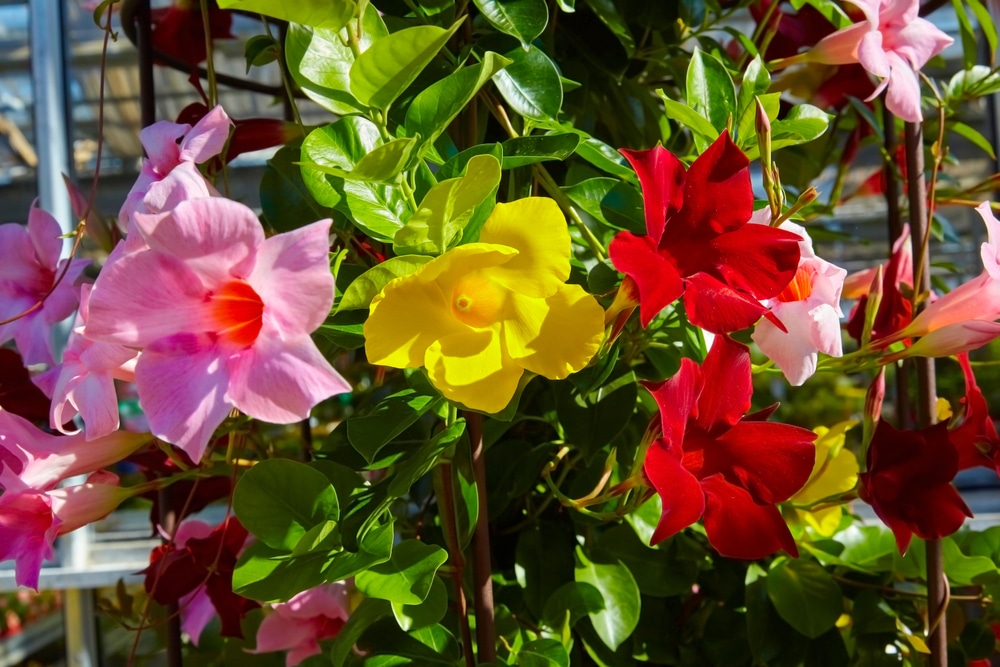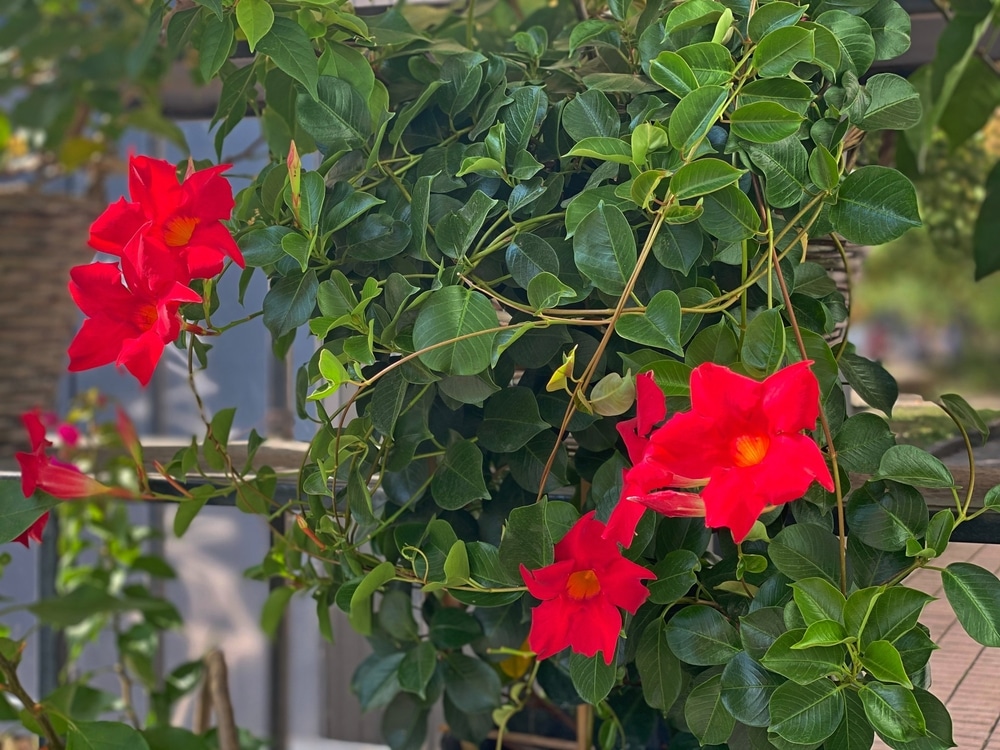Originating from Brazil, the Mandevilla Sanderiy is a beautiful flowering vine known for its bright red flowers. This fast-growing vine is relatively easy to care for, and doesn’t shy away from producing an abundance of flowers when in season. With its vibrant flowers, it’s no wonder this plant is a popular choice for adding color and life to any garden.
If you’re thinking of adding a Mandevilla Sanderi to your own garden, here’s what you need to know about care and maintenance:
| Botanical Name |
Mandevilla Sanderi |
| Common Name | Brazilian Jasmine |
| Plant Type | Perennial |
| Flower Color | White, Red, Pink |
| Size When Mature |
84-180 inches |
| Bloom Time |
Summer and Fall |
| Sun Requirements | Full to Partial Sun |
| USDA Hardiness Zones | 10 – 11 |
| Soil PH Range | 6.5 – 7.8 |
| Soil Type | Slightly Acidic, Neutral, Alkaline, Well-draining |
| Water Needs | Medium |
| Native Area | Brazil |
What You Need to Know About Mandevilla Sanderi
The Mandevilla Sanderi, also known as Brazillian Jasmine, is a gorgeous climbing plant that can quickly transform any garden with its beautiful red flowers. This plant is native to Brazil and is known for being a fast grower. As it matures, it can reach up to 15 feet tall.
Its leaves are glossy and dark green, with a leathery texture. Also, they are elliptical in shape, growing to be about 4 inches long with the edges of the leaves being serrated, and arranged in opposite pairs on the stem. Additionally, the underside of the leaf is lighter in color and often has a velvet-like texture.
The plant has a very distinctive appearance, thanks to its large flowers that bloom during summer and fall. They can have different colors depending on the variety, like white, red, or pink. Also, each flower is around five centimeters in diameter and is clustered together in groups of three. Additionally, the flowers have a very sweet scent and are often used in perfumes and lotions.
However, the plant is toxic if ingested, so it is important to keep this in mind if you have pets or small children.
How to Care for Mandevilla Sanderi
Here’s everything you need to know about growing and caring for a thriving Mandevilla Sanderi:
Light
The first step to take when caring for your Mandevilla Sanderi is to provide it with ample light. This tropical plant thrives in bright, indirect sunlight. In order to flower well, it requires at least four hours of sunlight each day. Remember that too much direct sunlight can scorch its leaves, so finding the right balance plays an important role.
Even though it needs a lot of light, it can still tolerate some partial shade, especially during the hottest hours of the day.
Water and Soil Needs
One of the most important things to remember when caring for your Mandevilla Sanderi is to water it regularly. This tropical plant thrives in humid conditions, so be sure to mist it frequently or keep a pebble tray filled with water underneath its pot. Water the soil directly when it feels dry to the touch, but make sure not to overdo it – too much water can cause the roots to rot.
In terms of soil, you’ll want to use a well-draining, sandy soil mix and make sure the pH levels are between 6.6 and 780. You can test the pH levels with a simple at-home test kit. Once you’ve got the perfect mix, you can add some organic matter to help the plant retain moisture. This is especially important in hot, dry climates.
Temperature Requirements
As a tropical plant, the Mandevilla Sanderi prefers warm weather with temperatures of at least 45°F. Dropping below this temperature can cause the plant to go into shock and die. If you live in an area with cold winters, it’s best to grow your plant indoors or in a greenhouse where you can control the temperature. Additionally, they are hardy in USDA zones 10-11.
Fertilizer
The best fertilizer to use on a Mandevilla Sanderi is a water-soluble fertilizer that high in phosphorus. Using a fertilizer with high phosphorus content will encourage blooming and ensure your garden will be filled with its flowers. You can fertilize your plant once a month during the spring and summer months, but be sure to reduce the frequency to every other month or so in the fall and winter.
Common Diseases
Although the Mandevilla Sanderi is relatively easy to care for, it is still susceptible to root rot. Root rot is the most common disease of the plant, which can be caused by overwatering or poor drainage. Some symptoms include yellowing leaves, wilting, and stunted growth. If not treated quickly, root rot can kill the plant.
The biggest problem that the plant faces is pests. They are susceptible to red spider mites, scales, whiteflies, and aphids. For example, red spider mites are tiny, red spider-like creatures that suck the sap from the plant, causing the leaves to turn yellow and eventually drop off. Another example is scales, which are small, hard-shelled pests that attach themselves to the leaves and stems of the plant, robbing it of its vital nutrients.
The best way to prevent pests is to keep an eye out for them and act quickly if you see any. Be sure to inspect your plant regularly, especially if it’s been exposed to other plants that may have pests. If you see any pests, you can remove them by hand or treat the plant with an insecticide.
Mandevilla Sanderi Propagation
The Mandevilla Sanderi is an easy plant to propagate. You can do this through seed or stem cuttings.
To propagate by seed, start with fresh seeds that have been stratified for two weeks. Plant the seeds in a well-draining soil mix, keeping the soil sufficiently moist. After that, place the pot in a warm location out of direct sunlight, and wait for the seeds to germinate. Thin out the seedlings to ensure that the strongest ones remain.
Finally, when the seedlings are large enough to handle, transplant them into individual pots.
To propagate by stem cuttings, take 4-6 inch cuttings from new growth in the spring or summer. Remove the bottom leaves and dip the cuttings. An optional way to speed up the process is dipping these cuttings in rooting hormone. Alternatively, you can also just place the cutting in a glass of water. or moist soil mix.
Expect the cuttings should root within 4-6 weeks.


